Why Spring Green Minestrone Is My Seasonal Favorite
The first time I made Spring Green Minestrone was during culinary school in San Francisco, and it was a revelation. This wasn’t the heavy, tomato-rich soup I knew—it was bright, green, and fresh. With sweet peas, green beans, and tender leafy greens in a light but flavorful broth, Spring Green Minestrone felt like eating the season itself.
Table of Contents
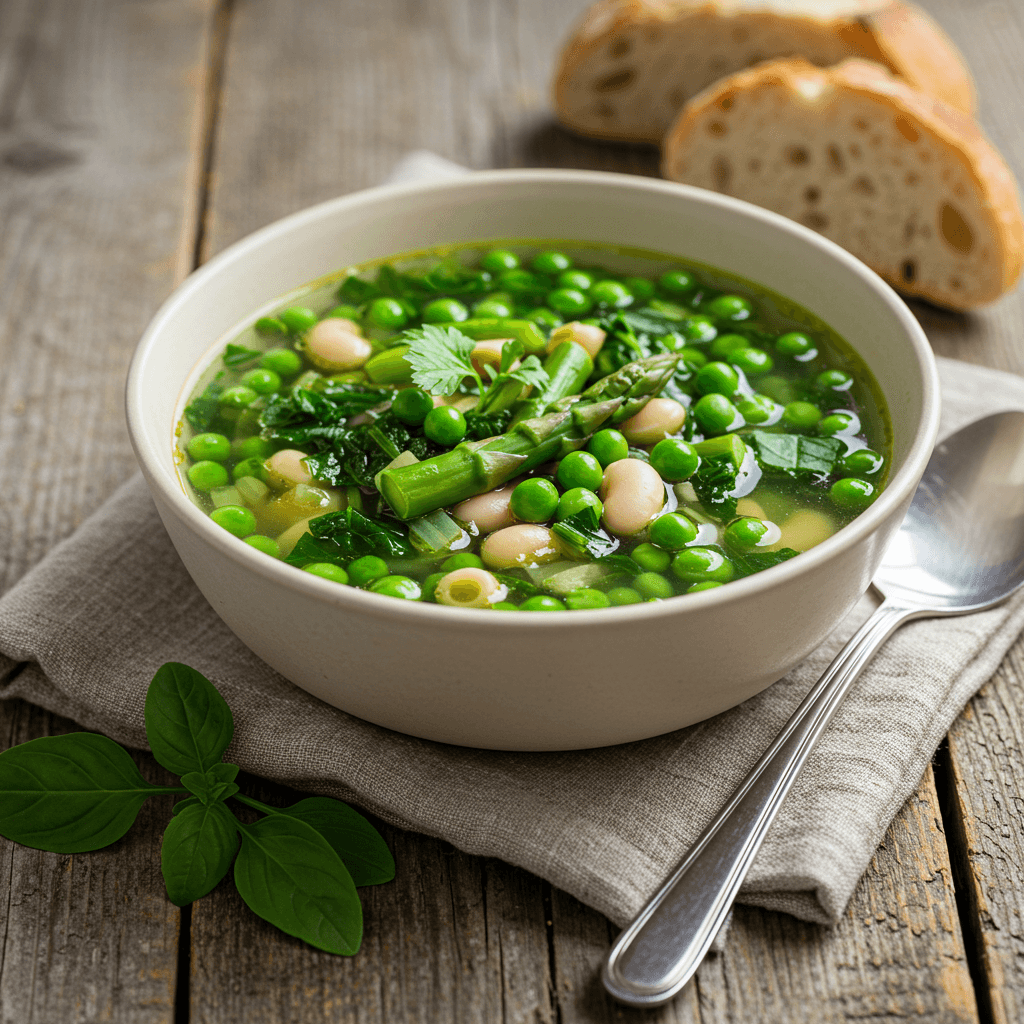
When I moved back to Boulder, I adapted it to whatever the local farmers’ market offered. Sometimes that meant adding spinach or kale picked that morning. Other times, it was basil and tender green garlic. It’s the kind of dish that teaches you to respect what’s in season and to use it in a way that truly shines.
One of my favorite ways to serve Spring Green Minestrone is with crusty bread and a side of something chilled. On hot days, I’ll pair it with my Chilled Cucumber Avocado Soup for a full meal that feels like summer on a plate.
This soup is one of those back-pocket recipes that can be fancy enough for guests yet easy enough for weeknights. It’s about celebrating the greens and herbs that make spring cooking so joyful.
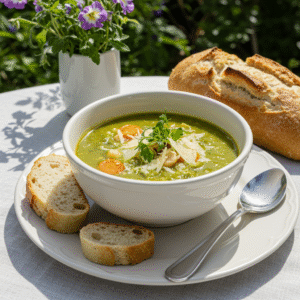
Spring Green Minestrone
Equipment
- large soup pot
- wooden spoon
- knife
- Cutting board
- ladle
Ingredients
- 2 tbsp olive oil
- 1 yellow onion, diced
- 1 carrot, diced
- 2 stalks celery, diced
- 3 cloves garlic, minced
- 4 cups vegetable broth
- 1 cup green beans, trimmed and cut into 1-inch pieces
- 1 cup peas (fresh or frozen)
- 2 cups baby spinach or kale
- 1 zucchini, diced
- 1 lemon (juice and zest)
- 2 tbsp pesto (optional for finishing)
- 1 parmesan rind (optional, omit for vegan)
- to taste salt and pepper
Instructions
- Heat olive oil in a large pot over medium heat. Add onion, carrot, and celery. Cook slowly until softened and aromatic (about 8–10 minutes).
- Add garlic and cook for 1–2 minutes until fragrant. Stir in salt, pepper, and optional red pepper flakes.
- Pour in the vegetable broth and bring to a gentle simmer. Add the zucchini and optional parmesan rind. Simmer for about 10 minutes.
- Add green beans and peas. Cook for another 5 minutes until just tender.
- Stir in the baby spinach or kale and cook until wilted (1–2 minutes). Remove parmesan rind if used.
- Remove from heat. Stir in lemon juice and zest. Optionally, swirl in pesto before serving.
Notes
Nutrition
The Secret to Getting That Fresh, Green Flavor
Here’s the thing about Spring Green Minestrone: it’s not just minestrone with peas tossed in. The broth is the foundation. I like to start with a rich vegetable stock—either homemade or a good-quality store-bought one—and build flavor by sautéing onion and garlic in olive oil first.
But the real trick? Add those delicate green vegetables at the very end so they keep their color and texture. Peas, green beans, spinach, and kale all work beautifully. A spoonful of pesto stirred in at the end is my go-to move for adding depth without heaviness.
I often finish it with a squeeze of lemon juice or zest to make the flavors pop. That little bit of acid transforms the soup from simple to something that feels bright and restaurant-worthy.
If you’re planning a summer meal, try pairing Spring Green Minestrone with my Watermelon Gazpacho—the sweet, chilled soup is an amazing contrast to the warm, herby broth.
This combination of fresh vegetables, gentle aromatics, and a bit of culinary intuition is why I keep coming back to Spring Green Minestrone every spring. It’s the taste of the season in a bowl, and once you try it, you’ll see why it’s worth making again and again.
Spring Green Minestrone Variations
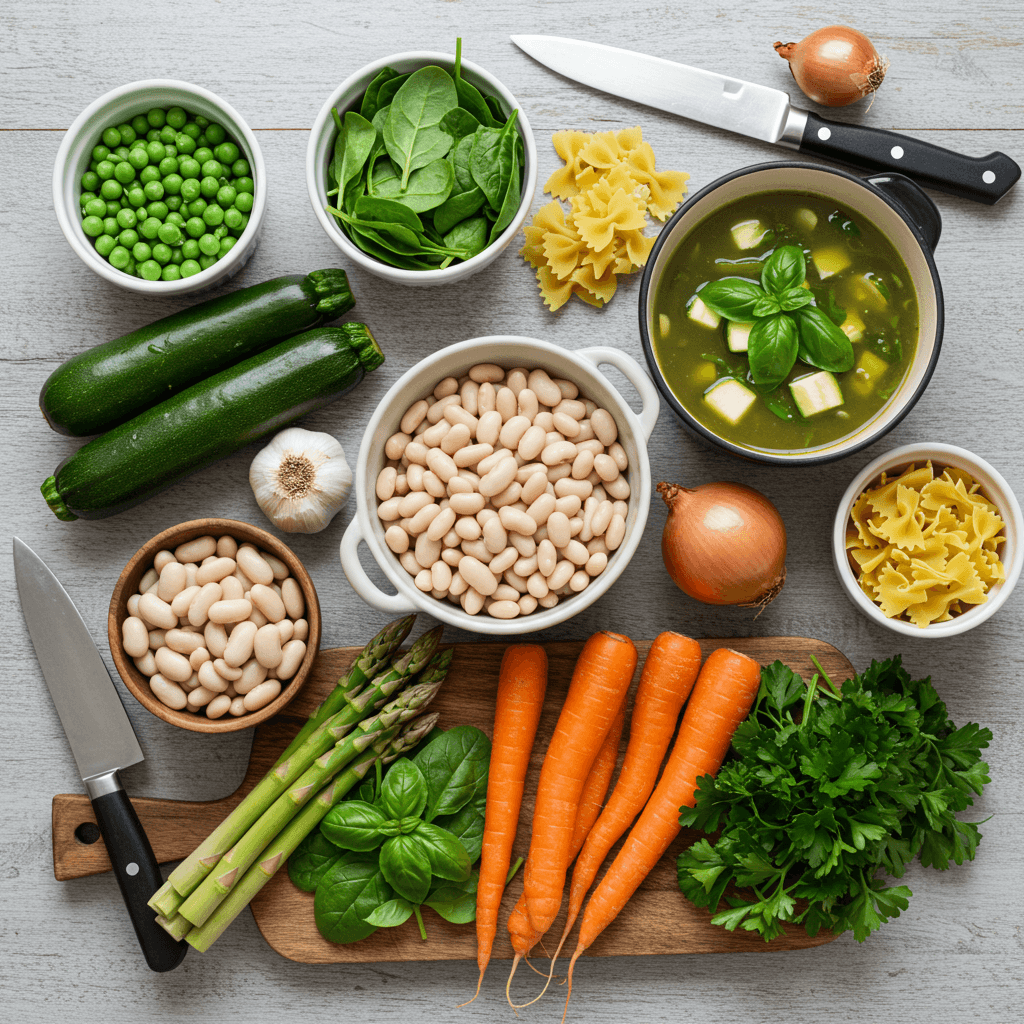
Adding Protein or Pasta for a Heartier Meal
One of the best things about Spring Green Minestrone is how adaptable it is. If you want something heartier, adding pasta or beans turns this light soup into a filling meal. Tiny shapes like ditalini, orzo, or even broken spaghetti work beautifully.
Cannellini or chickpeas are my favorite additions—they bring creaminess without cream. I also love stirring in shredded chicken if I’m making it for a more protein-focused dinner.
When I want to serve a meal that feels special but still easy, I’ll pair it with a slice of my Savory Rosemary Focaccia for dipping. The olive oil-rich bread soaks up the herbal broth in the best way.
This versatility is why Spring Green Minestrone is such a staple in my kitchen. You can keep it vegan, make it protein-rich, or even toss in leftover roasted vegetables to clean out the fridge.
Playing with Seasonal Greens and Herbs
Spring Green Minestrone isn’t just a recipe—it’s a framework you can adapt to what’s freshest. In early spring, I’ll use baby kale or chard, while later in the season, tender spinach or even fresh basil leaves become the stars.
One trick I love is stirring in a spoonful of pesto right before serving. It melts into the broth and adds an herbal, garlicky kick that makes every spoonful sing.
If you want more cold soup ideas to balance a warm bowl of Spring Green Minestrone, try my Chilled Corn Soup. It’s creamy, lightly sweet, and the perfect cool companion to this green, savory classic.
Whether you’re feeding a crowd or meal-prepping for the week, this soup offers endless room to make it your own. Just taste as you go and trust the produce—spring always delivers.
Cooking Tips and Seasonal Secrets
How to Layer Flavor in Spring Green Minestrone
Building flavor is what turns Spring Green Minestrone from simple to truly satisfying. I always start with a classic soffritto: onion, carrot, and celery cooked slowly in olive oil until everything is soft and aromatic. This creates a naturally sweet, savory base without needing anything fancy.
Next, I add garlic and sometimes a pinch of red pepper flakes for gentle warmth. The broth choice matters, too—a good-quality vegetable broth (or even homemade) will give your Spring Green Minestrone a depth that boxed versions often miss.
I like to finish with a splash of fresh lemon juice or white wine vinegar to brighten things up before serving. That acid balances the sweetness of the spring vegetables and makes the herbs pop.
If you’re looking for more ideas for bright, seasonal soups, you might love my Watermelon Gazpacho. It’s light, refreshing, and perfect when you want something cool alongside your warm bowl.
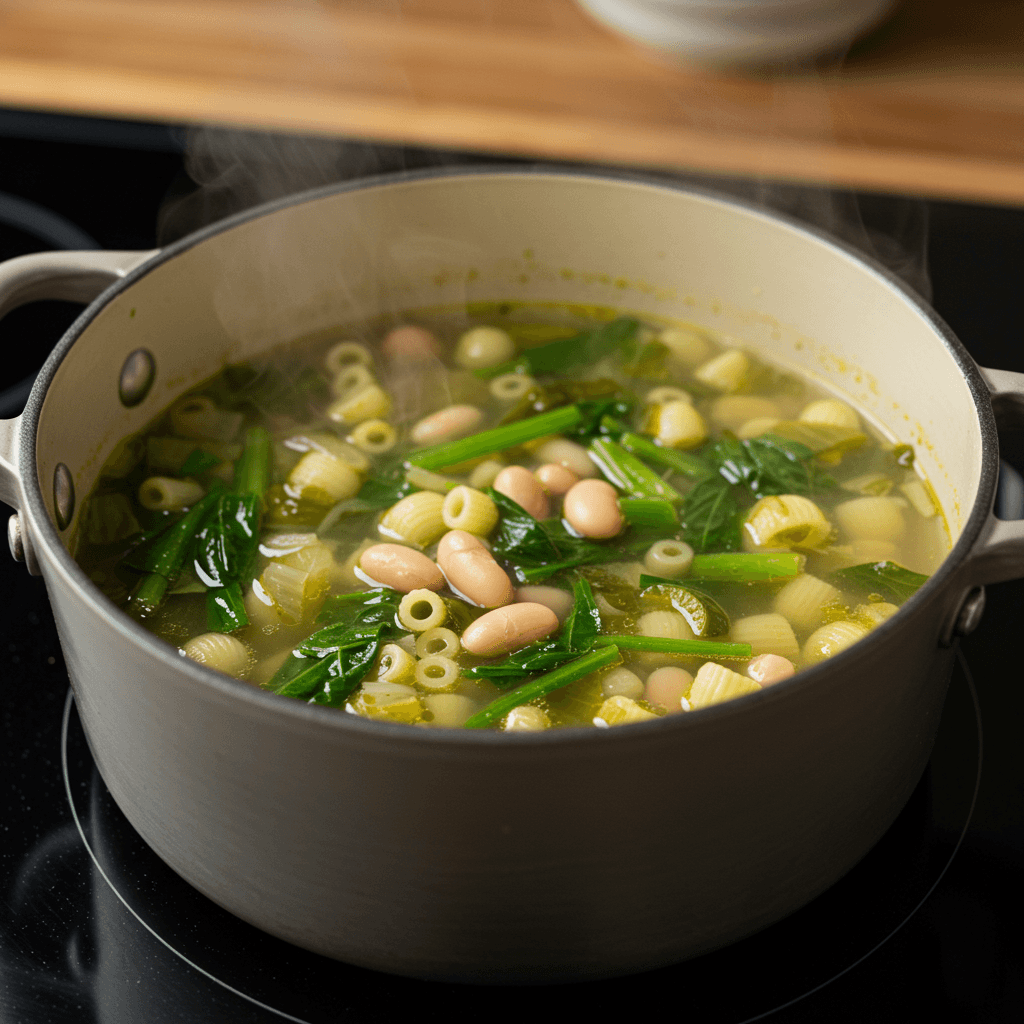
Making It Ahead and Storing It Right
One of the joys of Spring Green Minestrone is that it actually tastes better the next day. The flavors deepen overnight, making it an excellent make-ahead meal.
If you’re adding pasta, cook it separately and stir it in just before serving so it doesn’t soak up all the broth. The same goes for delicate greens like spinach—wait to add them until reheating.
Store leftovers in a sealed container in the fridge for up to 4 days. For longer storage, skip the pasta and greens and freeze the base for up to 2 months.
For those who want other nourishing, veggie-forward options, check out my Classic Gazpacho Spanish Cold Tomato Soup. It’s another warm-weather favorite that’s all about fresh, simple ingredients.
FAQs About Spring Green Minestrone
What is spring minestrone soup?
Spring Green Minestrone is a lighter, seasonal twist on the classic Italian soup. It features tender spring vegetables like peas, asparagus, and baby greens. Unlike hearty winter versions, this one is brothy and bright, with fresh herbs and sometimes a squeeze of lemon. It’s perfect for showcasing what’s fresh at the farmers’ market.
If you love seasonal spins on classics, my Chilled Corn Soup is another fantastic way to highlight summer produce in a cool, silky format.
What greens go in minestrone?
I often use baby spinach, kale, or Swiss chard in Spring Green Minestrone. Even arugula adds a peppery bite if you toss it in at the end. The goal is to add tender greens that wilt just before serving, giving you freshness and a pop of color without overcooking.
What is the secret ingredient in minestrone soup?
It’s all about layering flavors slowly. For me, the secret is the soffritto base and a splash of acid at the end—lemon or vinegar. It wakes up all the other flavors. You can also add a parmesan rind while simmering to deepen the broth if you’re not keeping it vegan.
Is there a difference between minestrone and minestrone?
That’s a trick question! There’s just one minestrone—but countless variations. Spring Green Minestrone is just one of them, tailored for light, fresh ingredients of the season. In Italy, every region—and even every family—has their own take. That’s part of the fun.
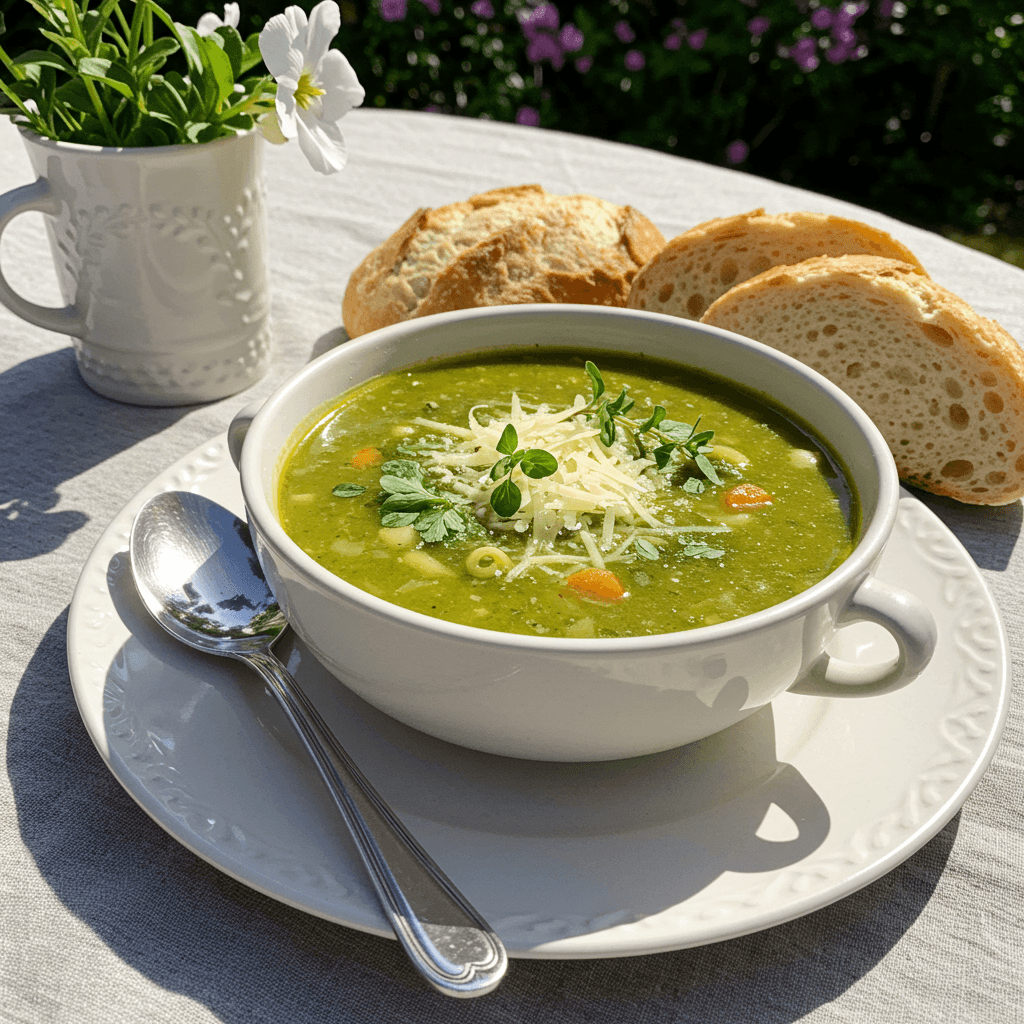
Conclusion
Spring Green Minestrone is one of those recipes you’ll find yourself returning to all season. It’s endlessly adaptable, easy to make ahead, and celebrates the best of the garden. Whether you’re ladling it steaming hot on a chilly evening or warming up leftovers for a quick lunch, you’ll get that unbeatable freshness in every bite.
If you’re in the mood to try other bright, veggie-forward dishes, my Chilled Cucumber Avocado Soup is a beautiful, no-cook option that’s just as satisfying on warm days.
For more on how Mediterranean soups like minestrone support healthy eating, check out the Harvard T.H. Chan School of Public Health’s Mediterranean Diet Guide. It’s a solid resource for understanding why these simple, vegetable-rich recipes are so nourishing.
So grab your basket, hit the market, and let’s make something delicious with what spring has to offer!
